Dissertation: Operation Performance Improvement for AF-Courts' Success
VerifiedAdded on 2022/09/08
|33
|8948
|17
Thesis and Dissertation
AI Summary
This dissertation examines the competitive advantage of Andy Food Courts (AF-Courts) and its improvement through operational performance enhancements within the Andy Central Kitchen (ACK). The study delves into the food industry's competitive landscape, analyzing AF-Courts' business model, including its food products, competitors, and customer segments. It explores the strategic management of resources, capabilities, and core competencies, along with supply chain and operations management concepts, including lean and agile methodologies. The research methodology encompasses data collection and analysis to evaluate the impact of operational improvements on AF-Courts' performance. The dissertation reviews the literature on strategic management, supply chain, and operations management, while also considering factors like food waste and the role of marketing and sales. The objective is to identify strategies for enhancing AF-Courts' competitive position through improved operational efficiency, quality, and customer responsiveness.

Dissertation
Paraphrase This Document
Need a fresh take? Get an instant paraphrase of this document with our AI Paraphraser
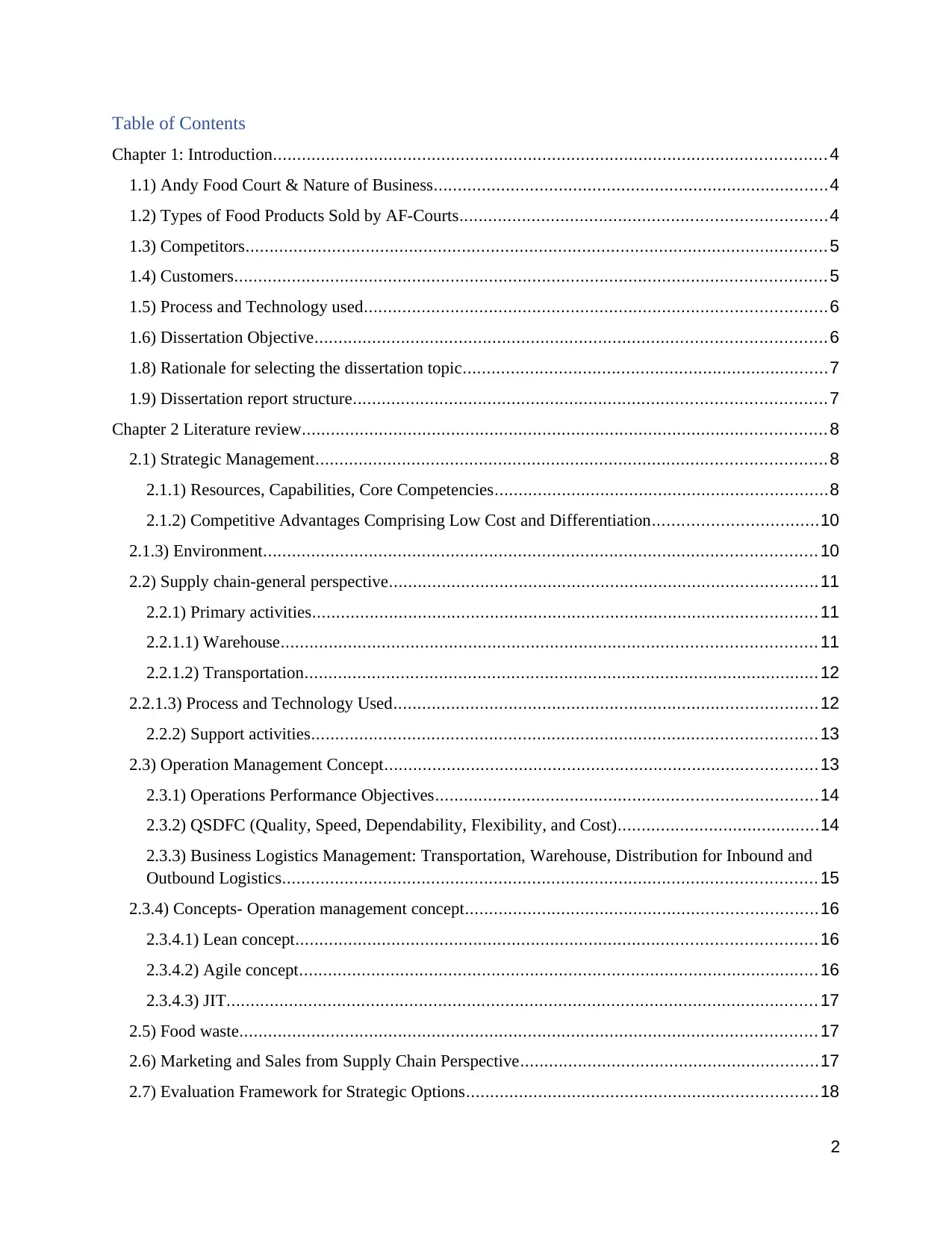
Table of Contents
Chapter 1: Introduction................................................................................................................... 4
1.1) Andy Food Court & Nature of Business..................................................................................4
1.2) Types of Food Products Sold by AF-Courts............................................................................4
1.3) Competitors......................................................................................................................... 5
1.4) Customers........................................................................................................................... 5
1.5) Process and Technology used................................................................................................6
1.6) Dissertation Objective..........................................................................................................6
1.8) Rationale for selecting the dissertation topic............................................................................7
1.9) Dissertation report structure..................................................................................................7
Chapter 2 Literature review............................................................................................................. 8
2.1) Strategic Management..........................................................................................................8
2.1.1) Resources, Capabilities, Core Competencies.....................................................................8
2.1.2) Competitive Advantages Comprising Low Cost and Differentiation..................................10
2.1.3) Environment................................................................................................................... 10
2.2) Supply chain-general perspective.........................................................................................11
2.2.1) Primary activities.........................................................................................................11
2.2.1.1) Warehouse............................................................................................................... 11
2.2.1.2) Transportation...........................................................................................................12
2.2.1.3) Process and Technology Used........................................................................................12
2.2.2) Support activities.........................................................................................................13
2.3) Operation Management Concept..........................................................................................13
2.3.1) Operations Performance Objectives...............................................................................14
2.3.2) QSDFC (Quality, Speed, Dependability, Flexibility, and Cost)..........................................14
2.3.3) Business Logistics Management: Transportation, Warehouse, Distribution for Inbound and
Outbound Logistics............................................................................................................... 15
2.3.4) Concepts- Operation management concept.........................................................................16
2.3.4.1) Lean concept............................................................................................................ 16
2.3.4.2) Agile concept............................................................................................................16
2.3.4.3) JIT........................................................................................................................... 17
2.5) Food waste........................................................................................................................ 17
2.6) Marketing and Sales from Supply Chain Perspective..............................................................17
2.7) Evaluation Framework for Strategic Options.........................................................................18
2
Chapter 1: Introduction................................................................................................................... 4
1.1) Andy Food Court & Nature of Business..................................................................................4
1.2) Types of Food Products Sold by AF-Courts............................................................................4
1.3) Competitors......................................................................................................................... 5
1.4) Customers........................................................................................................................... 5
1.5) Process and Technology used................................................................................................6
1.6) Dissertation Objective..........................................................................................................6
1.8) Rationale for selecting the dissertation topic............................................................................7
1.9) Dissertation report structure..................................................................................................7
Chapter 2 Literature review............................................................................................................. 8
2.1) Strategic Management..........................................................................................................8
2.1.1) Resources, Capabilities, Core Competencies.....................................................................8
2.1.2) Competitive Advantages Comprising Low Cost and Differentiation..................................10
2.1.3) Environment................................................................................................................... 10
2.2) Supply chain-general perspective.........................................................................................11
2.2.1) Primary activities.........................................................................................................11
2.2.1.1) Warehouse............................................................................................................... 11
2.2.1.2) Transportation...........................................................................................................12
2.2.1.3) Process and Technology Used........................................................................................12
2.2.2) Support activities.........................................................................................................13
2.3) Operation Management Concept..........................................................................................13
2.3.1) Operations Performance Objectives...............................................................................14
2.3.2) QSDFC (Quality, Speed, Dependability, Flexibility, and Cost)..........................................14
2.3.3) Business Logistics Management: Transportation, Warehouse, Distribution for Inbound and
Outbound Logistics............................................................................................................... 15
2.3.4) Concepts- Operation management concept.........................................................................16
2.3.4.1) Lean concept............................................................................................................ 16
2.3.4.2) Agile concept............................................................................................................16
2.3.4.3) JIT........................................................................................................................... 17
2.5) Food waste........................................................................................................................ 17
2.6) Marketing and Sales from Supply Chain Perspective..............................................................17
2.7) Evaluation Framework for Strategic Options.........................................................................18
2

2.8) Research Methods.............................................................................................................. 19
2.9) Cochran Formula:.............................................................................................................. 20
Chapter 3: Methodology............................................................................................................... 21
3.1) Research approach............................................................................................................. 21
3.2) Data collection methods......................................................................................................21
3.2.1) Primary data collection method.....................................................................................21
3.3) Sample.............................................................................................................................. 21
3.4) Data Analysis Method........................................................................................................21
References................................................................................................................................... 30
3
2.9) Cochran Formula:.............................................................................................................. 20
Chapter 3: Methodology............................................................................................................... 21
3.1) Research approach............................................................................................................. 21
3.2) Data collection methods......................................................................................................21
3.2.1) Primary data collection method.....................................................................................21
3.3) Sample.............................................................................................................................. 21
3.4) Data Analysis Method........................................................................................................21
References................................................................................................................................... 30
3
⊘ This is a preview!⊘
Do you want full access?
Subscribe today to unlock all pages.

Trusted by 1+ million students worldwide
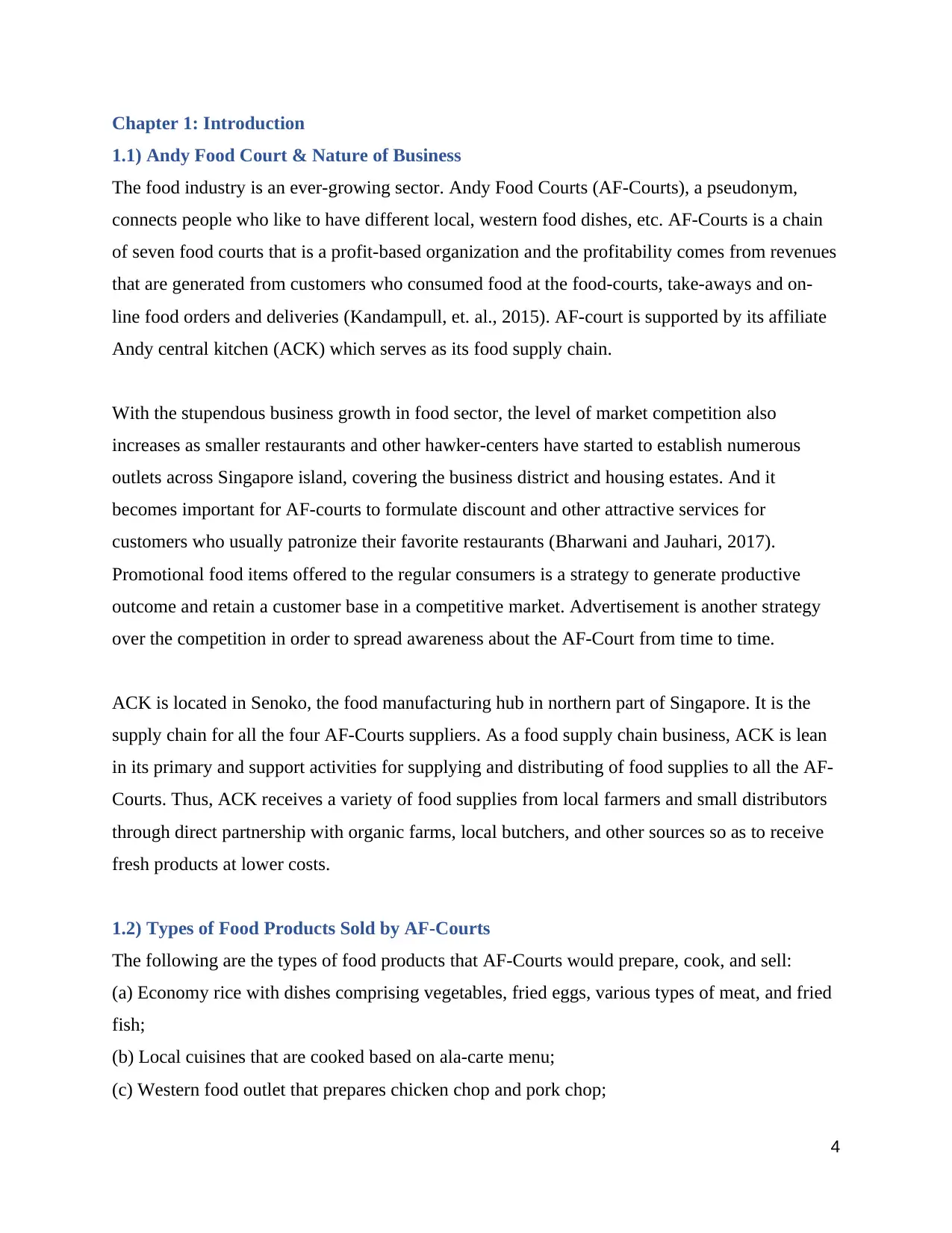
Chapter 1: Introduction
1.1) Andy Food Court & Nature of Business
The food industry is an ever-growing sector. Andy Food Courts (AF-Courts), a pseudonym,
connects people who like to have different local, western food dishes, etc. AF-Courts is a chain
of seven food courts that is a profit-based organization and the profitability comes from revenues
that are generated from customers who consumed food at the food-courts, take-aways and on-
line food orders and deliveries (Kandampull, et. al., 2015). AF-court is supported by its affiliate
Andy central kitchen (ACK) which serves as its food supply chain.
With the stupendous business growth in food sector, the level of market competition also
increases as smaller restaurants and other hawker-centers have started to establish numerous
outlets across Singapore island, covering the business district and housing estates. And it
becomes important for AF-courts to formulate discount and other attractive services for
customers who usually patronize their favorite restaurants (Bharwani and Jauhari, 2017).
Promotional food items offered to the regular consumers is a strategy to generate productive
outcome and retain a customer base in a competitive market. Advertisement is another strategy
over the competition in order to spread awareness about the AF-Court from time to time.
ACK is located in Senoko, the food manufacturing hub in northern part of Singapore. It is the
supply chain for all the four AF-Courts suppliers. As a food supply chain business, ACK is lean
in its primary and support activities for supplying and distributing of food supplies to all the AF-
Courts. Thus, ACK receives a variety of food supplies from local farmers and small distributors
through direct partnership with organic farms, local butchers, and other sources so as to receive
fresh products at lower costs.
1.2) Types of Food Products Sold by AF-Courts
The following are the types of food products that AF-Courts would prepare, cook, and sell:
(a) Economy rice with dishes comprising vegetables, fried eggs, various types of meat, and fried
fish;
(b) Local cuisines that are cooked based on ala-carte menu;
(c) Western food outlet that prepares chicken chop and pork chop;
4
1.1) Andy Food Court & Nature of Business
The food industry is an ever-growing sector. Andy Food Courts (AF-Courts), a pseudonym,
connects people who like to have different local, western food dishes, etc. AF-Courts is a chain
of seven food courts that is a profit-based organization and the profitability comes from revenues
that are generated from customers who consumed food at the food-courts, take-aways and on-
line food orders and deliveries (Kandampull, et. al., 2015). AF-court is supported by its affiliate
Andy central kitchen (ACK) which serves as its food supply chain.
With the stupendous business growth in food sector, the level of market competition also
increases as smaller restaurants and other hawker-centers have started to establish numerous
outlets across Singapore island, covering the business district and housing estates. And it
becomes important for AF-courts to formulate discount and other attractive services for
customers who usually patronize their favorite restaurants (Bharwani and Jauhari, 2017).
Promotional food items offered to the regular consumers is a strategy to generate productive
outcome and retain a customer base in a competitive market. Advertisement is another strategy
over the competition in order to spread awareness about the AF-Court from time to time.
ACK is located in Senoko, the food manufacturing hub in northern part of Singapore. It is the
supply chain for all the four AF-Courts suppliers. As a food supply chain business, ACK is lean
in its primary and support activities for supplying and distributing of food supplies to all the AF-
Courts. Thus, ACK receives a variety of food supplies from local farmers and small distributors
through direct partnership with organic farms, local butchers, and other sources so as to receive
fresh products at lower costs.
1.2) Types of Food Products Sold by AF-Courts
The following are the types of food products that AF-Courts would prepare, cook, and sell:
(a) Economy rice with dishes comprising vegetables, fried eggs, various types of meat, and fried
fish;
(b) Local cuisines that are cooked based on ala-carte menu;
(c) Western food outlet that prepares chicken chop and pork chop;
4
Paraphrase This Document
Need a fresh take? Get an instant paraphrase of this document with our AI Paraphraser
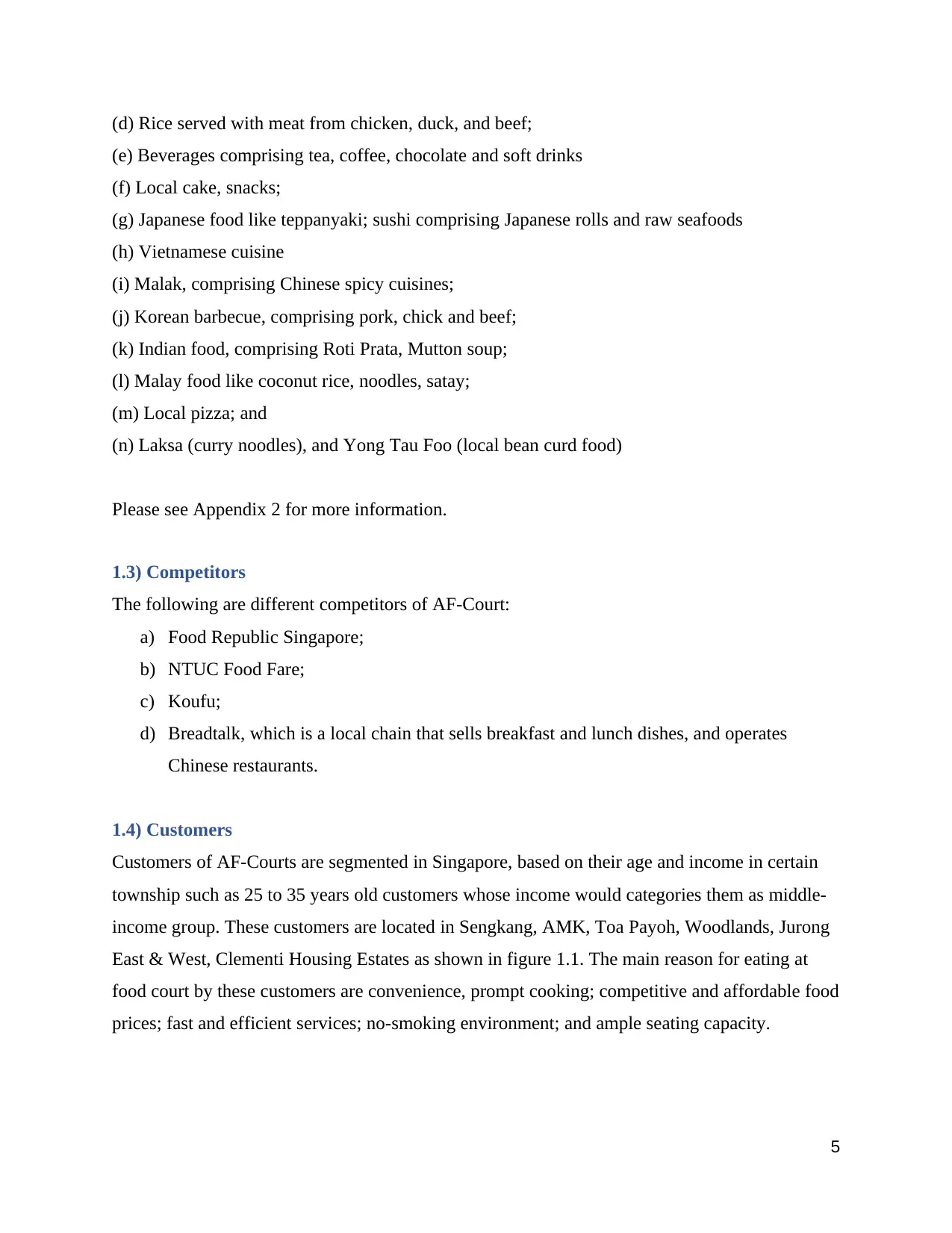
(d) Rice served with meat from chicken, duck, and beef;
(e) Beverages comprising tea, coffee, chocolate and soft drinks
(f) Local cake, snacks;
(g) Japanese food like teppanyaki; sushi comprising Japanese rolls and raw seafoods
(h) Vietnamese cuisine
(i) Malak, comprising Chinese spicy cuisines;
(j) Korean barbecue, comprising pork, chick and beef;
(k) Indian food, comprising Roti Prata, Mutton soup;
(l) Malay food like coconut rice, noodles, satay;
(m) Local pizza; and
(n) Laksa (curry noodles), and Yong Tau Foo (local bean curd food)
Please see Appendix 2 for more information.
1.3) Competitors
The following are different competitors of AF-Court:
a) Food Republic Singapore;
b) NTUC Food Fare;
c) Koufu;
d) Breadtalk, which is a local chain that sells breakfast and lunch dishes, and operates
Chinese restaurants.
1.4) Customers
Customers of AF-Courts are segmented in Singapore, based on their age and income in certain
township such as 25 to 35 years old customers whose income would categories them as middle-
income group. These customers are located in Sengkang, AMK, Toa Payoh, Woodlands, Jurong
East & West, Clementi Housing Estates as shown in figure 1.1. The main reason for eating at
food court by these customers are convenience, prompt cooking; competitive and affordable food
prices; fast and efficient services; no-smoking environment; and ample seating capacity.
5
(e) Beverages comprising tea, coffee, chocolate and soft drinks
(f) Local cake, snacks;
(g) Japanese food like teppanyaki; sushi comprising Japanese rolls and raw seafoods
(h) Vietnamese cuisine
(i) Malak, comprising Chinese spicy cuisines;
(j) Korean barbecue, comprising pork, chick and beef;
(k) Indian food, comprising Roti Prata, Mutton soup;
(l) Malay food like coconut rice, noodles, satay;
(m) Local pizza; and
(n) Laksa (curry noodles), and Yong Tau Foo (local bean curd food)
Please see Appendix 2 for more information.
1.3) Competitors
The following are different competitors of AF-Court:
a) Food Republic Singapore;
b) NTUC Food Fare;
c) Koufu;
d) Breadtalk, which is a local chain that sells breakfast and lunch dishes, and operates
Chinese restaurants.
1.4) Customers
Customers of AF-Courts are segmented in Singapore, based on their age and income in certain
township such as 25 to 35 years old customers whose income would categories them as middle-
income group. These customers are located in Sengkang, AMK, Toa Payoh, Woodlands, Jurong
East & West, Clementi Housing Estates as shown in figure 1.1. The main reason for eating at
food court by these customers are convenience, prompt cooking; competitive and affordable food
prices; fast and efficient services; no-smoking environment; and ample seating capacity.
5
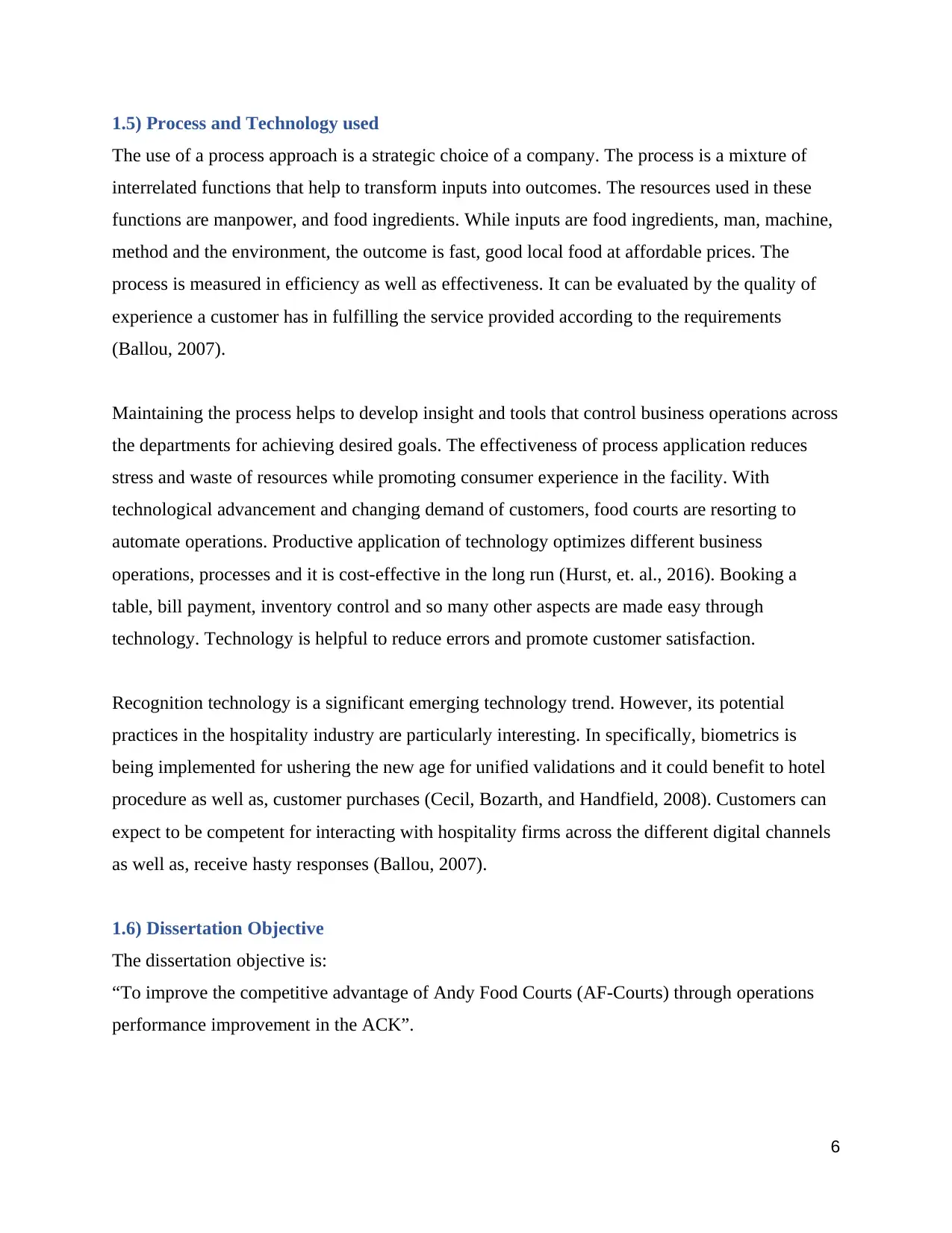
1.5) Process and Technology used
The use of a process approach is a strategic choice of a company. The process is a mixture of
interrelated functions that help to transform inputs into outcomes. The resources used in these
functions are manpower, and food ingredients. While inputs are food ingredients, man, machine,
method and the environment, the outcome is fast, good local food at affordable prices. The
process is measured in efficiency as well as effectiveness. It can be evaluated by the quality of
experience a customer has in fulfilling the service provided according to the requirements
(Ballou, 2007).
Maintaining the process helps to develop insight and tools that control business operations across
the departments for achieving desired goals. The effectiveness of process application reduces
stress and waste of resources while promoting consumer experience in the facility. With
technological advancement and changing demand of customers, food courts are resorting to
automate operations. Productive application of technology optimizes different business
operations, processes and it is cost-effective in the long run (Hurst, et. al., 2016). Booking a
table, bill payment, inventory control and so many other aspects are made easy through
technology. Technology is helpful to reduce errors and promote customer satisfaction.
Recognition technology is a significant emerging technology trend. However, its potential
practices in the hospitality industry are particularly interesting. In specifically, biometrics is
being implemented for ushering the new age for unified validations and it could benefit to hotel
procedure as well as, customer purchases (Cecil, Bozarth, and Handfield, 2008). Customers can
expect to be competent for interacting with hospitality firms across the different digital channels
as well as, receive hasty responses (Ballou, 2007).
1.6) Dissertation Objective
The dissertation objective is:
“To improve the competitive advantage of Andy Food Courts (AF-Courts) through operations
performance improvement in the ACK”.
6
The use of a process approach is a strategic choice of a company. The process is a mixture of
interrelated functions that help to transform inputs into outcomes. The resources used in these
functions are manpower, and food ingredients. While inputs are food ingredients, man, machine,
method and the environment, the outcome is fast, good local food at affordable prices. The
process is measured in efficiency as well as effectiveness. It can be evaluated by the quality of
experience a customer has in fulfilling the service provided according to the requirements
(Ballou, 2007).
Maintaining the process helps to develop insight and tools that control business operations across
the departments for achieving desired goals. The effectiveness of process application reduces
stress and waste of resources while promoting consumer experience in the facility. With
technological advancement and changing demand of customers, food courts are resorting to
automate operations. Productive application of technology optimizes different business
operations, processes and it is cost-effective in the long run (Hurst, et. al., 2016). Booking a
table, bill payment, inventory control and so many other aspects are made easy through
technology. Technology is helpful to reduce errors and promote customer satisfaction.
Recognition technology is a significant emerging technology trend. However, its potential
practices in the hospitality industry are particularly interesting. In specifically, biometrics is
being implemented for ushering the new age for unified validations and it could benefit to hotel
procedure as well as, customer purchases (Cecil, Bozarth, and Handfield, 2008). Customers can
expect to be competent for interacting with hospitality firms across the different digital channels
as well as, receive hasty responses (Ballou, 2007).
1.6) Dissertation Objective
The dissertation objective is:
“To improve the competitive advantage of Andy Food Courts (AF-Courts) through operations
performance improvement in the ACK”.
6
⊘ This is a preview!⊘
Do you want full access?
Subscribe today to unlock all pages.

Trusted by 1+ million students worldwide
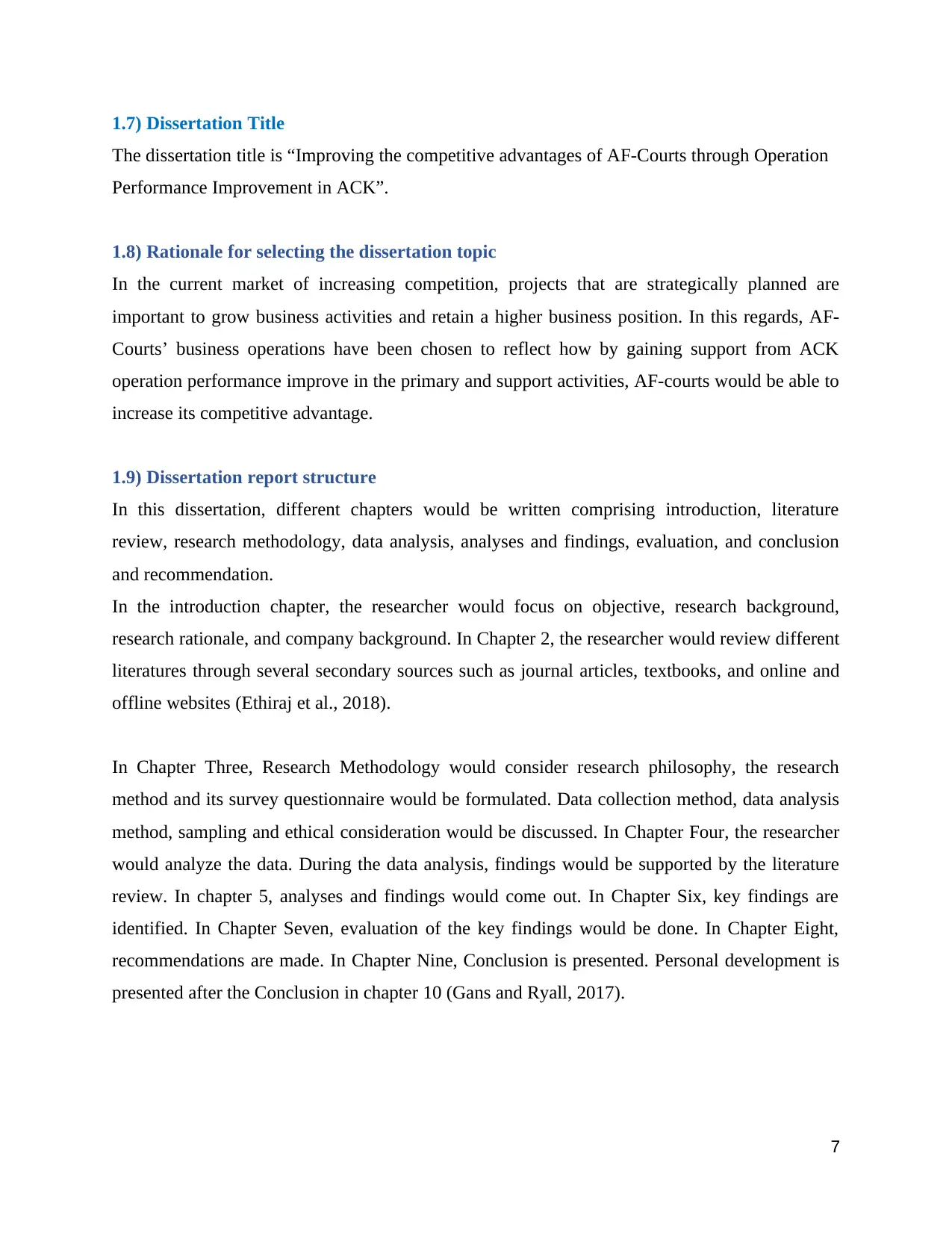
1.7) Dissertation Title
The dissertation title is “Improving the competitive advantages of AF-Courts through Operation
Performance Improvement in ACK”.
1.8) Rationale for selecting the dissertation topic
In the current market of increasing competition, projects that are strategically planned are
important to grow business activities and retain a higher business position. In this regards, AF-
Courts’ business operations have been chosen to reflect how by gaining support from ACK
operation performance improve in the primary and support activities, AF-courts would be able to
increase its competitive advantage.
1.9) Dissertation report structure
In this dissertation, different chapters would be written comprising introduction, literature
review, research methodology, data analysis, analyses and findings, evaluation, and conclusion
and recommendation.
In the introduction chapter, the researcher would focus on objective, research background,
research rationale, and company background. In Chapter 2, the researcher would review different
literatures through several secondary sources such as journal articles, textbooks, and online and
offline websites (Ethiraj et al., 2018).
In Chapter Three, Research Methodology would consider research philosophy, the research
method and its survey questionnaire would be formulated. Data collection method, data analysis
method, sampling and ethical consideration would be discussed. In Chapter Four, the researcher
would analyze the data. During the data analysis, findings would be supported by the literature
review. In chapter 5, analyses and findings would come out. In Chapter Six, key findings are
identified. In Chapter Seven, evaluation of the key findings would be done. In Chapter Eight,
recommendations are made. In Chapter Nine, Conclusion is presented. Personal development is
presented after the Conclusion in chapter 10 (Gans and Ryall, 2017).
7
The dissertation title is “Improving the competitive advantages of AF-Courts through Operation
Performance Improvement in ACK”.
1.8) Rationale for selecting the dissertation topic
In the current market of increasing competition, projects that are strategically planned are
important to grow business activities and retain a higher business position. In this regards, AF-
Courts’ business operations have been chosen to reflect how by gaining support from ACK
operation performance improve in the primary and support activities, AF-courts would be able to
increase its competitive advantage.
1.9) Dissertation report structure
In this dissertation, different chapters would be written comprising introduction, literature
review, research methodology, data analysis, analyses and findings, evaluation, and conclusion
and recommendation.
In the introduction chapter, the researcher would focus on objective, research background,
research rationale, and company background. In Chapter 2, the researcher would review different
literatures through several secondary sources such as journal articles, textbooks, and online and
offline websites (Ethiraj et al., 2018).
In Chapter Three, Research Methodology would consider research philosophy, the research
method and its survey questionnaire would be formulated. Data collection method, data analysis
method, sampling and ethical consideration would be discussed. In Chapter Four, the researcher
would analyze the data. During the data analysis, findings would be supported by the literature
review. In chapter 5, analyses and findings would come out. In Chapter Six, key findings are
identified. In Chapter Seven, evaluation of the key findings would be done. In Chapter Eight,
recommendations are made. In Chapter Nine, Conclusion is presented. Personal development is
presented after the Conclusion in chapter 10 (Gans and Ryall, 2017).
7
Paraphrase This Document
Need a fresh take? Get an instant paraphrase of this document with our AI Paraphraser
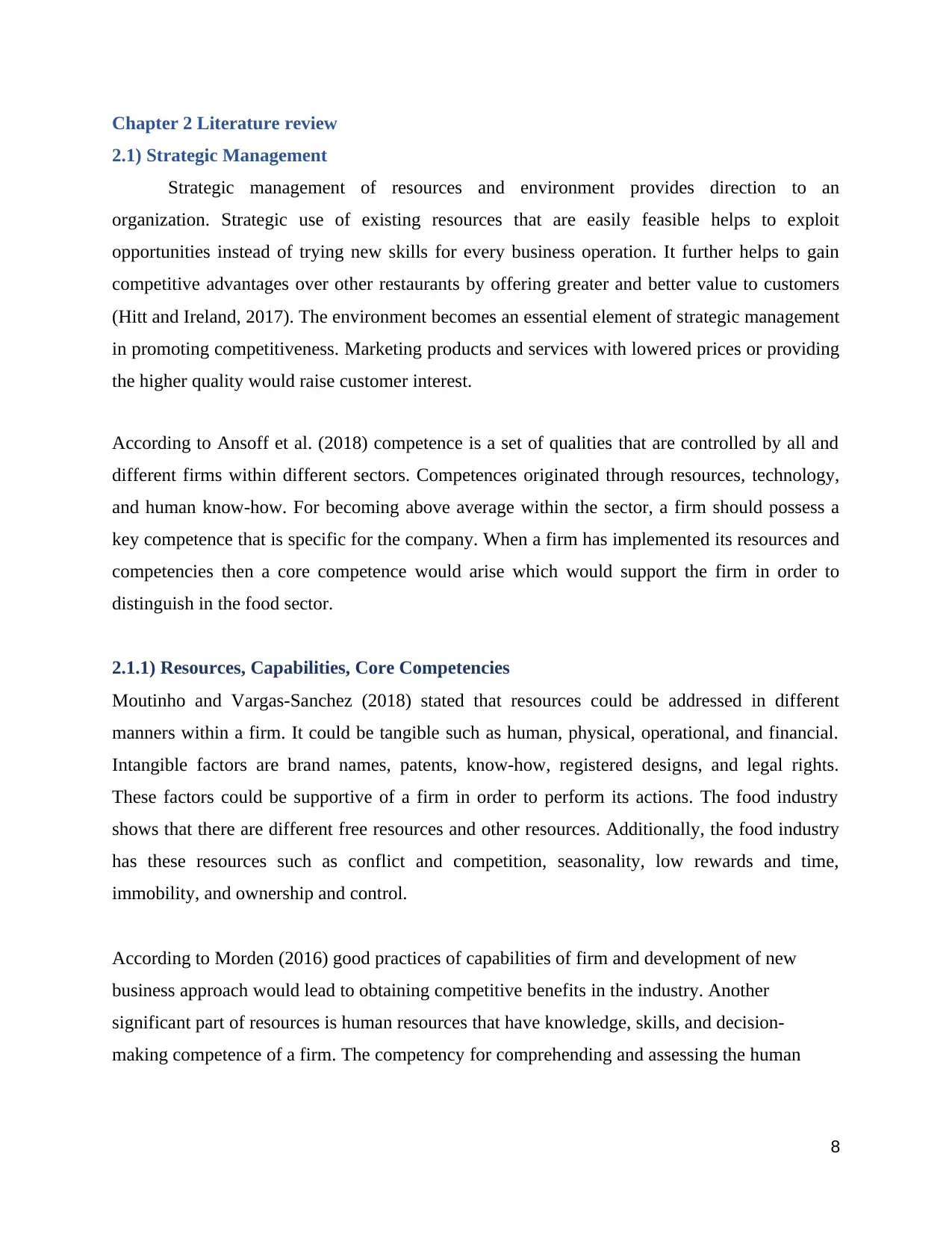
Chapter 2 Literature review
2.1) Strategic Management
Strategic management of resources and environment provides direction to an
organization. Strategic use of existing resources that are easily feasible helps to exploit
opportunities instead of trying new skills for every business operation. It further helps to gain
competitive advantages over other restaurants by offering greater and better value to customers
(Hitt and Ireland, 2017). The environment becomes an essential element of strategic management
in promoting competitiveness. Marketing products and services with lowered prices or providing
the higher quality would raise customer interest.
According to Ansoff et al. (2018) competence is a set of qualities that are controlled by all and
different firms within different sectors. Competences originated through resources, technology,
and human know-how. For becoming above average within the sector, a firm should possess a
key competence that is specific for the company. When a firm has implemented its resources and
competencies then a core competence would arise which would support the firm in order to
distinguish in the food sector.
2.1.1) Resources, Capabilities, Core Competencies
Moutinho and Vargas-Sanchez (2018) stated that resources could be addressed in different
manners within a firm. It could be tangible such as human, physical, operational, and financial.
Intangible factors are brand names, patents, know-how, registered designs, and legal rights.
These factors could be supportive of a firm in order to perform its actions. The food industry
shows that there are different free resources and other resources. Additionally, the food industry
has these resources such as conflict and competition, seasonality, low rewards and time,
immobility, and ownership and control.
According to Morden (2016) good practices of capabilities of firm and development of new
business approach would lead to obtaining competitive benefits in the industry. Another
significant part of resources is human resources that have knowledge, skills, and decision-
making competence of a firm. The competency for comprehending and assessing the human
8
2.1) Strategic Management
Strategic management of resources and environment provides direction to an
organization. Strategic use of existing resources that are easily feasible helps to exploit
opportunities instead of trying new skills for every business operation. It further helps to gain
competitive advantages over other restaurants by offering greater and better value to customers
(Hitt and Ireland, 2017). The environment becomes an essential element of strategic management
in promoting competitiveness. Marketing products and services with lowered prices or providing
the higher quality would raise customer interest.
According to Ansoff et al. (2018) competence is a set of qualities that are controlled by all and
different firms within different sectors. Competences originated through resources, technology,
and human know-how. For becoming above average within the sector, a firm should possess a
key competence that is specific for the company. When a firm has implemented its resources and
competencies then a core competence would arise which would support the firm in order to
distinguish in the food sector.
2.1.1) Resources, Capabilities, Core Competencies
Moutinho and Vargas-Sanchez (2018) stated that resources could be addressed in different
manners within a firm. It could be tangible such as human, physical, operational, and financial.
Intangible factors are brand names, patents, know-how, registered designs, and legal rights.
These factors could be supportive of a firm in order to perform its actions. The food industry
shows that there are different free resources and other resources. Additionally, the food industry
has these resources such as conflict and competition, seasonality, low rewards and time,
immobility, and ownership and control.
According to Morden (2016) good practices of capabilities of firm and development of new
business approach would lead to obtaining competitive benefits in the industry. Another
significant part of resources is human resources that have knowledge, skills, and decision-
making competence of a firm. The competency for comprehending and assessing the human
8

skills within a firm is complex. Over the year, firms have made efforts in order to develop a
technique in order to assess the performance and skill of workforce.
Ansoff et al. (2018) viewed that competence is a set of qualities that is controlled by all and
different firms within different sectors. Competences originated through resources, technology,
and human know-how. For becoming above average within the food sector, a firm should
possess a key competence that is specific for the company. When a firm has implemented its
resources and competencies then a core competence would arise and support the firm in order to
distinguish it in the food sector. These core competencies, which comprise superior efficiency,
superior quality, superior customer responsiveness, and superior innovation would desire
competitive advantageous for the companies (Jones and Hill, 2010).
2.1.1) Resources
Lasserre (2017) stated that there are different manners for assessing the resources by specificity,
by categories, and by performance. In this manner, categories would comprise financial
resources, physical resources, human resources, and intangible resources and then assesses it
qualitatively and quantitatively. Assessment by specificity is related to categorizing resources
into specific and non-specific resources.
Moreover, Meyer et al. (2017) stated that specific resources are related to ones that have
particular skills and knowledge as well as, non-specific are generally the ones i.e. basis for core
competencies. By performance, measures contribute to the internal and external performance of a
firm. The resources would have changed into the capabilities of the company since as themselves
they are not creative. Organizational capabilities are related to everything that aids a firm in
terms of keeping sound business and distinguish the firm in the industry. These capabilities as
well as, industry success factors would have to be considered in order to develop an effective
approach.
Good practices of capabilities of firm, and development of new approach would lead to obtaining
competitive benefits in the industry (Morden, 2016). Another significant part of resources is
human resources that have knowledge, skills, and decision-making competence of a firm. The
competency for comprehending and assessing the human skills within a firm is complex and
9
technique in order to assess the performance and skill of workforce.
Ansoff et al. (2018) viewed that competence is a set of qualities that is controlled by all and
different firms within different sectors. Competences originated through resources, technology,
and human know-how. For becoming above average within the food sector, a firm should
possess a key competence that is specific for the company. When a firm has implemented its
resources and competencies then a core competence would arise and support the firm in order to
distinguish it in the food sector. These core competencies, which comprise superior efficiency,
superior quality, superior customer responsiveness, and superior innovation would desire
competitive advantageous for the companies (Jones and Hill, 2010).
2.1.1) Resources
Lasserre (2017) stated that there are different manners for assessing the resources by specificity,
by categories, and by performance. In this manner, categories would comprise financial
resources, physical resources, human resources, and intangible resources and then assesses it
qualitatively and quantitatively. Assessment by specificity is related to categorizing resources
into specific and non-specific resources.
Moreover, Meyer et al. (2017) stated that specific resources are related to ones that have
particular skills and knowledge as well as, non-specific are generally the ones i.e. basis for core
competencies. By performance, measures contribute to the internal and external performance of a
firm. The resources would have changed into the capabilities of the company since as themselves
they are not creative. Organizational capabilities are related to everything that aids a firm in
terms of keeping sound business and distinguish the firm in the industry. These capabilities as
well as, industry success factors would have to be considered in order to develop an effective
approach.
Good practices of capabilities of firm, and development of new approach would lead to obtaining
competitive benefits in the industry (Morden, 2016). Another significant part of resources is
human resources that have knowledge, skills, and decision-making competence of a firm. The
competency for comprehending and assessing the human skills within a firm is complex and
9
⊘ This is a preview!⊘
Do you want full access?
Subscribe today to unlock all pages.

Trusted by 1+ million students worldwide
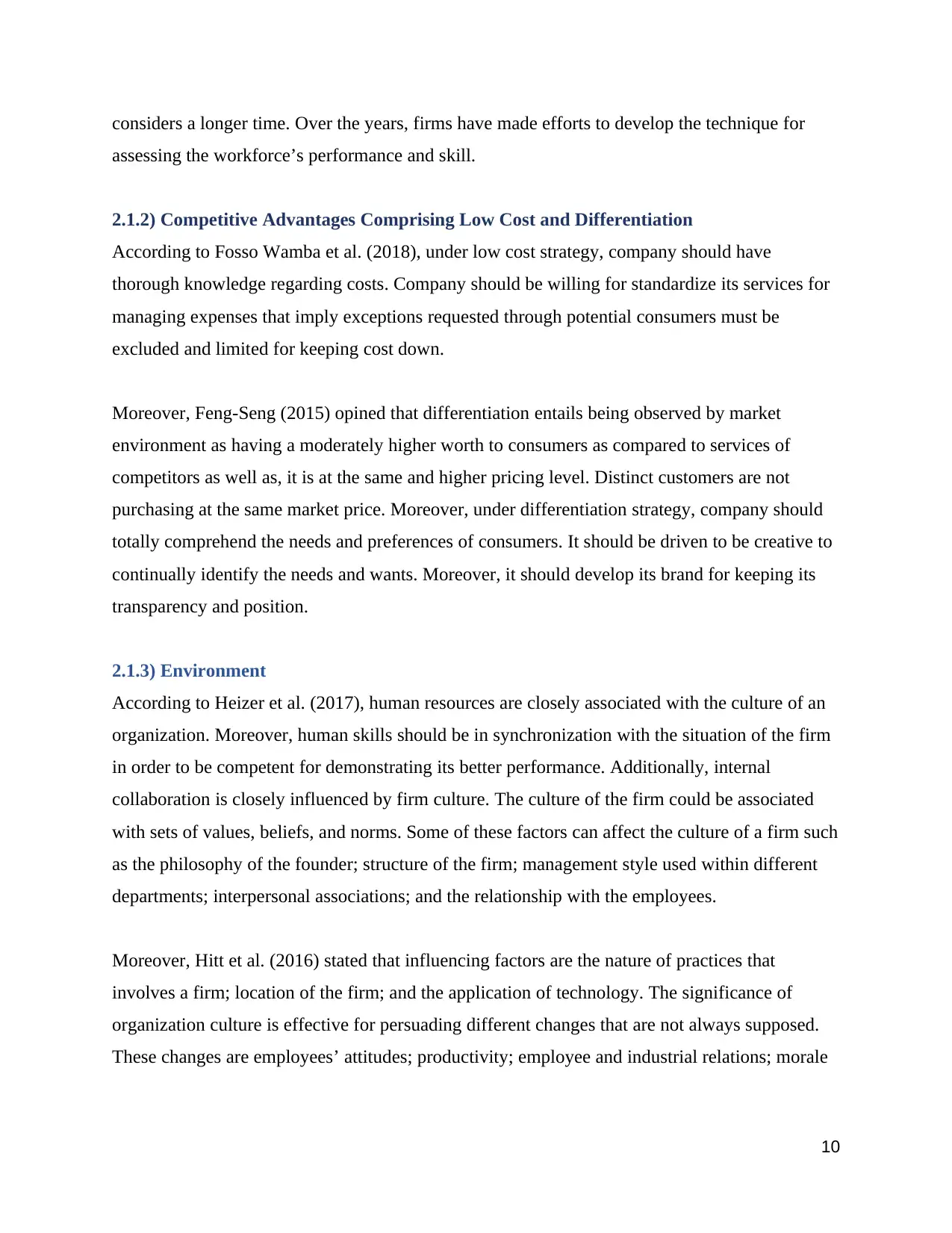
considers a longer time. Over the years, firms have made efforts to develop the technique for
assessing the workforce’s performance and skill.
2.1.2) Competitive Advantages Comprising Low Cost and Differentiation
According to Fosso Wamba et al. (2018), under low cost strategy, company should have
thorough knowledge regarding costs. Company should be willing for standardize its services for
managing expenses that imply exceptions requested through potential consumers must be
excluded and limited for keeping cost down.
Moreover, Feng-Seng (2015) opined that differentiation entails being observed by market
environment as having a moderately higher worth to consumers as compared to services of
competitors as well as, it is at the same and higher pricing level. Distinct customers are not
purchasing at the same market price. Moreover, under differentiation strategy, company should
totally comprehend the needs and preferences of consumers. It should be driven to be creative to
continually identify the needs and wants. Moreover, it should develop its brand for keeping its
transparency and position.
2.1.3) Environment
According to Heizer et al. (2017), human resources are closely associated with the culture of an
organization. Moreover, human skills should be in synchronization with the situation of the firm
in order to be competent for demonstrating its better performance. Additionally, internal
collaboration is closely influenced by firm culture. The culture of the firm could be associated
with sets of values, beliefs, and norms. Some of these factors can affect the culture of a firm such
as the philosophy of the founder; structure of the firm; management style used within different
departments; interpersonal associations; and the relationship with the employees.
Moreover, Hitt et al. (2016) stated that influencing factors are the nature of practices that
involves a firm; location of the firm; and the application of technology. The significance of
organization culture is effective for persuading different changes that are not always supposed.
These changes are employees’ attitudes; productivity; employee and industrial relations; morale
10
assessing the workforce’s performance and skill.
2.1.2) Competitive Advantages Comprising Low Cost and Differentiation
According to Fosso Wamba et al. (2018), under low cost strategy, company should have
thorough knowledge regarding costs. Company should be willing for standardize its services for
managing expenses that imply exceptions requested through potential consumers must be
excluded and limited for keeping cost down.
Moreover, Feng-Seng (2015) opined that differentiation entails being observed by market
environment as having a moderately higher worth to consumers as compared to services of
competitors as well as, it is at the same and higher pricing level. Distinct customers are not
purchasing at the same market price. Moreover, under differentiation strategy, company should
totally comprehend the needs and preferences of consumers. It should be driven to be creative to
continually identify the needs and wants. Moreover, it should develop its brand for keeping its
transparency and position.
2.1.3) Environment
According to Heizer et al. (2017), human resources are closely associated with the culture of an
organization. Moreover, human skills should be in synchronization with the situation of the firm
in order to be competent for demonstrating its better performance. Additionally, internal
collaboration is closely influenced by firm culture. The culture of the firm could be associated
with sets of values, beliefs, and norms. Some of these factors can affect the culture of a firm such
as the philosophy of the founder; structure of the firm; management style used within different
departments; interpersonal associations; and the relationship with the employees.
Moreover, Hitt et al. (2016) stated that influencing factors are the nature of practices that
involves a firm; location of the firm; and the application of technology. The significance of
organization culture is effective for persuading different changes that are not always supposed.
These changes are employees’ attitudes; productivity; employee and industrial relations; morale
10
Paraphrase This Document
Need a fresh take? Get an instant paraphrase of this document with our AI Paraphraser

and goodwill of workforces; and the attractiveness of the firm as an employer. These factors may
increase the chances of high business returns.
2.2) Supply chain-general perspective
Frynas and Mellahi (2015) stated that there are certain processes that are a key foundation for
food supply chain management such as transformation of raw material, processing,
manufacturing and semi-finished food products.
A supply chain has to interlink the firm and its suppliers in order to reduce cost, and avoid time-
consuming and tedious processes (Stadtler, 2015). Supply chain comprises inbound logistics,
operations, outbound logistics, marketing and sales, and customer services. Poor planning that is
based on outdated data, along with a plan that does not reflect present reality will generate issue.
The need of a quick response to customer demand requires optimized supply to the business
leading to a hundred percent satisfaction at minimal cost for a meal.
2.2.1) Primary activities
The primary activities comprise five activities. These activities directly consider selling and
production of actual product. They also embody the physical development of product, its sales,
transferring to the purchasers and after sale support. These activities are categorized into inbound
logistics, operations, outbound logistics, marketing & sales, as well as, services.
2.2.1.1) Warehouse
According to Fahimnia et al. (2015) under the food warehouse atmosphere, better warehouse
management is translated into better space utilization. A critical component to handle perishable
food items should be managed by the operations system with the promptness to prevent
contamination and spoilage. Additionally, high volume picks items could be strategically placed
together as well as, near the door. More logical space allocations, and leaner inventory can be
achieved, leading a decline in inventory levels and inventory holding costs.
Moreover, Swink et al. (2017) evaluated that inventory costs can be decreased through visibility
in the food warehouses through using the Warehouse Management System (WMS). This type of
11
increase the chances of high business returns.
2.2) Supply chain-general perspective
Frynas and Mellahi (2015) stated that there are certain processes that are a key foundation for
food supply chain management such as transformation of raw material, processing,
manufacturing and semi-finished food products.
A supply chain has to interlink the firm and its suppliers in order to reduce cost, and avoid time-
consuming and tedious processes (Stadtler, 2015). Supply chain comprises inbound logistics,
operations, outbound logistics, marketing and sales, and customer services. Poor planning that is
based on outdated data, along with a plan that does not reflect present reality will generate issue.
The need of a quick response to customer demand requires optimized supply to the business
leading to a hundred percent satisfaction at minimal cost for a meal.
2.2.1) Primary activities
The primary activities comprise five activities. These activities directly consider selling and
production of actual product. They also embody the physical development of product, its sales,
transferring to the purchasers and after sale support. These activities are categorized into inbound
logistics, operations, outbound logistics, marketing & sales, as well as, services.
2.2.1.1) Warehouse
According to Fahimnia et al. (2015) under the food warehouse atmosphere, better warehouse
management is translated into better space utilization. A critical component to handle perishable
food items should be managed by the operations system with the promptness to prevent
contamination and spoilage. Additionally, high volume picks items could be strategically placed
together as well as, near the door. More logical space allocations, and leaner inventory can be
achieved, leading a decline in inventory levels and inventory holding costs.
Moreover, Swink et al. (2017) evaluated that inventory costs can be decreased through visibility
in the food warehouses through using the Warehouse Management System (WMS). This type of
11

visibility endorses higher visibility of shipments of materials into the warehouse; and provides
better utilization of personnel and space. The WMS facilitates a constant stream of data for the
user that permits them to optimize their performance within the warehouse. Along with this, food
warehouse that uses WMS would achieve comprehensive transparency in their warehouse;
optimize warehouse activities, and increase productivity.
With the real requirement for promptly pushing fresh products by using WMS, it facilitates the
type of high-end functionality that could deal with large volumes of difficult orders (Meredith
and Shafer, 2019). With significant integration of advanced warehouse technology and
engagement of employees, food warehouses, particularly those managing fresh foods, would
become a vibrant center of productivity and efficiency; and error-proofing, making it favorable
for improved food materials storage and handling; and safety from mixed up; deterioration and
contamination
2.2.1.2) Transportation
Transportation is imperative field. It is known that vehicle selection and routing are important
because transportation could directly impact the delivery, in-transit storage and protection of
food materials from environmental elements such as heat, rain and dust would affect
organizational performance (Heizer et al., 2017).
Moreover, the food industry is usually confronted with operational problems that affect the
growth rate of particular products and services (Hitt et al., 2016).
2.2.1.3) Process and Technology Used
Warehousing and warehouse material handling equipment could be integrated through using
WMS, Order Management System (OMS), and Transportation Management System (Ballou,
2007; Harrison and Van Hoek, 2008).
In the immediate future, artificial intelligence and data assessment (Lynch, 2018), and ‘Internet
of Things’ would be used in business logistics functions together with smart devices
12
better utilization of personnel and space. The WMS facilitates a constant stream of data for the
user that permits them to optimize their performance within the warehouse. Along with this, food
warehouse that uses WMS would achieve comprehensive transparency in their warehouse;
optimize warehouse activities, and increase productivity.
With the real requirement for promptly pushing fresh products by using WMS, it facilitates the
type of high-end functionality that could deal with large volumes of difficult orders (Meredith
and Shafer, 2019). With significant integration of advanced warehouse technology and
engagement of employees, food warehouses, particularly those managing fresh foods, would
become a vibrant center of productivity and efficiency; and error-proofing, making it favorable
for improved food materials storage and handling; and safety from mixed up; deterioration and
contamination
2.2.1.2) Transportation
Transportation is imperative field. It is known that vehicle selection and routing are important
because transportation could directly impact the delivery, in-transit storage and protection of
food materials from environmental elements such as heat, rain and dust would affect
organizational performance (Heizer et al., 2017).
Moreover, the food industry is usually confronted with operational problems that affect the
growth rate of particular products and services (Hitt et al., 2016).
2.2.1.3) Process and Technology Used
Warehousing and warehouse material handling equipment could be integrated through using
WMS, Order Management System (OMS), and Transportation Management System (Ballou,
2007; Harrison and Van Hoek, 2008).
In the immediate future, artificial intelligence and data assessment (Lynch, 2018), and ‘Internet
of Things’ would be used in business logistics functions together with smart devices
12
⊘ This is a preview!⊘
Do you want full access?
Subscribe today to unlock all pages.

Trusted by 1+ million students worldwide
1 out of 33
Related Documents
Your All-in-One AI-Powered Toolkit for Academic Success.
+13062052269
info@desklib.com
Available 24*7 on WhatsApp / Email
![[object Object]](/_next/static/media/star-bottom.7253800d.svg)
Unlock your academic potential
Copyright © 2020–2025 A2Z Services. All Rights Reserved. Developed and managed by ZUCOL.




